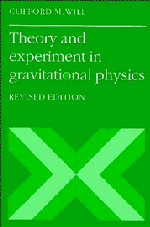Book contents
- Frontmatter
- Contents
- Preface to Revised Edition
- Preface to First Edition
- 1 Introduction
- 2 The Einstein Equivalence Principle and the Foundations of Gravitation Theory
- 3 Gravitation as a Geometric Phenomenon
- 4 The Parametrized Post-Newtonian Formalism
- 5 Post-Newtonian Limits of Alternative Metric Theories of Gravity
- 6 Equations of Motion in the PPN Formalism
- 7 The Classical Tests
- 8 Tests of the Strong Equivalence Principle
- 9 Other Tests of Post-Newtonian Gravity
- 10 Gravitational Radiation as a Tool for Testing Relativistic Gravity
- 11 Structure and Motion of Compact Objects in Alternative Theories of Gravity
- 12 The Binary Pulsar
- 13 Cosmological Tests
- 14 An Update
- References
- References to Chapter 14
- Index
5 - Post-Newtonian Limits of Alternative Metric Theories of Gravity
Published online by Cambridge University Press: 04 April 2011
- Frontmatter
- Contents
- Preface to Revised Edition
- Preface to First Edition
- 1 Introduction
- 2 The Einstein Equivalence Principle and the Foundations of Gravitation Theory
- 3 Gravitation as a Geometric Phenomenon
- 4 The Parametrized Post-Newtonian Formalism
- 5 Post-Newtonian Limits of Alternative Metric Theories of Gravity
- 6 Equations of Motion in the PPN Formalism
- 7 The Classical Tests
- 8 Tests of the Strong Equivalence Principle
- 9 Other Tests of Post-Newtonian Gravity
- 10 Gravitational Radiation as a Tool for Testing Relativistic Gravity
- 11 Structure and Motion of Compact Objects in Alternative Theories of Gravity
- 12 The Binary Pulsar
- 13 Cosmological Tests
- 14 An Update
- References
- References to Chapter 14
- Index
Summary
We now breathe some life into the PPN formalism by presenting a chapter full of metric theories of gravity and their post-Newtonian limits. This chapter will illustrate an important application of the PPN formalism, that of comparing and classifying theories of gravity. We begin in Section 5.1 with a discussion of the general method of calculating post-Newtonian limits of metric theories of gravity. The theories to be discussed in this chapter are divided into three classes. The first class is that of purely dynamical theories (see Section 3.3). These include general relativity in Section 5.2; scalar–tensor theories, of which the Brans–Dicke theory is a special case in Section 5.3; and vector–tensor theories in Section 5.4. The second class is that of theories with prior geometry. These include bimetric theories in Section 5.5; and “stratified” theories in Section 5.6. The theories described in detail in these five sections are those of which we are aware that have a reasonable chance of agreeing with present solar system experiments, to be described in Chapters 7, 8, and 9. Table 5.1 presents the PPN parameter values for the theories described in these five sections. The third class of theories includes those that, while perhaps thought once to have been viable, are in serious violation of one or more solar system tests. These will be described briefly in Section 5.7.
- Type
- Chapter
- Information
- Theory and Experiment in Gravitational Physics , pp. 116 - 141Publisher: Cambridge University PressPrint publication year: 1993

